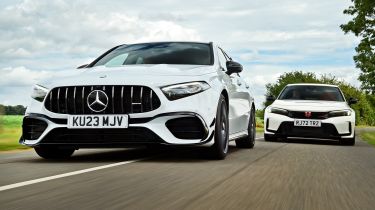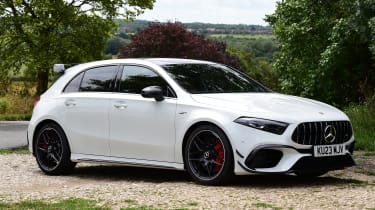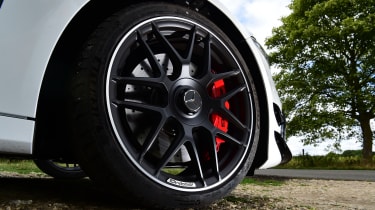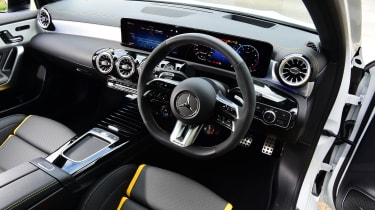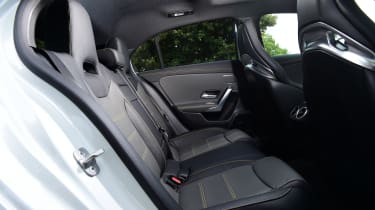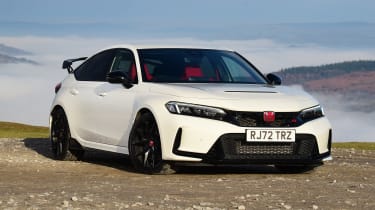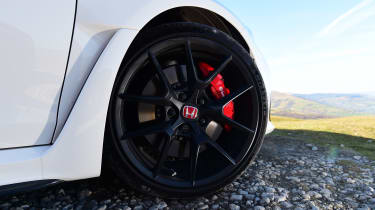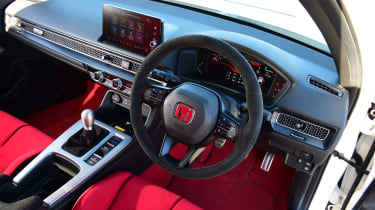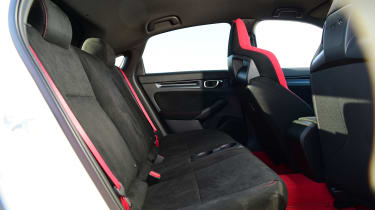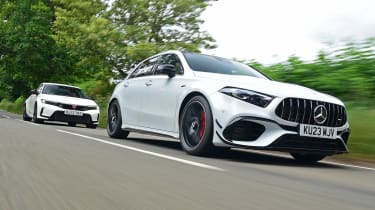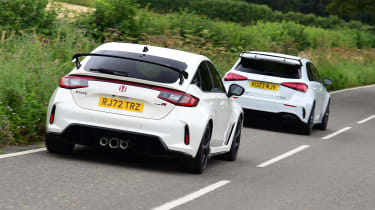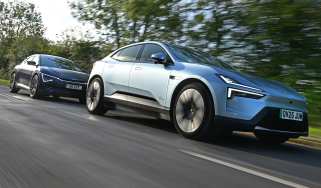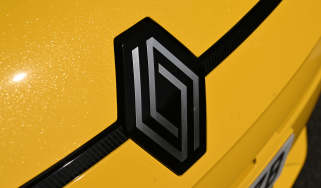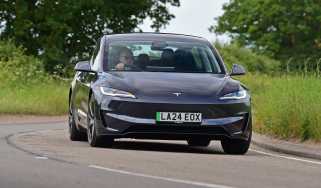Mercedes-AMG A45 S vs Honda Civic Type R: 2023 twin test review
A refresh has upped the ante for Mercedes-AMG’s A 45 S. How does it shape up against our reigning Hot Hatch of the Year, the Honda Civic Type R?
What we have here are two of the most brilliant hot hatchbacks that money can buy today. First is the Mercedes-AMG A 45 S, a car which, in its previous generation, came to define the hyper-hatch, and this version has taken things on to another level. There’s a facelift for 2023, so we wanted to put it up against another of the modern greats.
The Honda Civic Type R has long punched above its weight, with the performance to see off rivals from the mainstream brands, and make many people question why there’s any need to go for a premium alternative, such as the A 45. But when push comes to shove, does the Honda really have what it takes to see off its German rival?
| Mercedes-AMG A 45 S 4MATIC+ Plus | Honda Civic Type R | |
| Price: | £62,285 | £49,995 |
| Powertrain: | 2.0-litre 4cyl turbo, 415bhp | 2.0-litre 4cyl turbo, 324bhp |
| 0-62mph: | 3.9 seconds | 5.4 seconds |
| Test efficiency: | 31/3mph/6.8mpl | 29mpg/6.4mpl |
| CO2: | 208g/km | 186g/km |
| Annual VED: | £570 | £570 |
Mercedes-AMG A 45 S
At £63,285, the A 45 S costs an incredible amount of money for a five-door hatchback, but there’s a huge amount of bespoke engineering to justify the Mercedes-AMG’s price tag.
Tech highlights
Mechanically, the A 45 S is identical to before. Not that the 2.0-litre turbocharged four-cylinder petrol engine needed more power, anyway; it kicks out 415bhp at 7,200rpm and 500Nm of torque. AMG’s engineers shaped the torque curve so that peak shove arrives at a fairly heady 5,000rpm.
Used - available now

2022 Mercedes
GLA
34,858 milesAutomaticPetrol1.3L
Cash £24,300
2021 Volkswagen
Polo
68,420 milesManualPetrol1.0L
Cash £11,300
2025 Audi
A5 Sportback
36,484 milesAutomaticPetrol2.0L
Cash £20,800
2022 Fiat
500
22,184 milesManualPetrol1.0L
Cash £9,200The block itself has been rotated 180 degrees relative to other A-Class engines, which means the turbocharger and exhaust manifold face the rear of the car and the intake is at the front, improving airflow both in and out of the motor.
An aluminium crankcase, optimised exhaust valves (larger than on the previous A 45) and specific cooling systems all help to achieve a specific output of 208bhp per litre. Drive is sent through an eight-speed dual-clutch gearbox to all four wheels, and two clutches on the back axle distribute drive to either wheel more precisely to enhance traction when driving hard.
Chassis: To keep that power in check, AMG’s engineers have also reinforced the standard A-Class body. Most obvious is the addition of a strut brace to create a more stable platform for the suspension, but additional bracing between the inner A-pillars and the side members, diagonal struts down below, plus an aluminium shear plate under the engine all increase rigidity, too.
The MacPherson-strut front suspension gets aluminium lower wishbones to save weight, and the four-link rear axle is rigidly mounted to the chassis to improve control. Specific spring rates and adaptive dampers also feature.
On the road
In terms of pace, usability, refinement and fun, the A 45 S is a staggeringly strong all-rounder.
Around town: While there’s an overlying firmness to the way that the A 45 S rides, it’s more sophisticated and more forgiving than many other hot hatches. This means that it doesn’t feel harsh, only tightly controlled. The eight-speed gearbox can occasionally feel a little jerky at low speeds.
A & B-roads: That compliance in the suspension allows the A 45 S to flow with a twisty, uneven B-road rather than smashing it into submission.It also delivers lots of feedback as the outer springs load up through a turn, giving the driver the confidence to play with both the throttle and steering mid-corner to alter the car’s balance.
The steering also helps here; although it’s quite light, it’s very precise and loads up naturally as you lean on it. That the A 45 S can achieve all of this while delivering such mind-boggling levels of grip is outstanding. Very little else on the road is as fast point to point, or as engaging with it.
And then there’s the performance. The A 45 S has genuine supercar-baiting speed, and it feels every bit as rapid as the 3.9-second 0-62mph time suggests. Thanks to that high peak torque, there’s a genuine incentive for the driver to rev the engine out, unlike in many turbocharged engines, and use all of the power available. At full chat, the dual-clutch transmission is sharp enough to keep pace.
Motorway: Even in the harshest damper settings, the A 45 S remains composed and comfortable at high speeds, and it’s very stable, too. The only downside is that its fat tyres generate a substantial amount of road noise that the cabin struggles to isolate from its occupants.
Ownership
Even by the standards of mid-life facelifts, the cosmetic changes to the A 45 S are very subtle; they mirror the tweaks made to the rest of the A-Class line-up, albeit with an AMG twist.
The front and rear LED lights have been given minor tweaks, with new daytime-running graphics for the headlamps. There is also a new alloy-wheel design. The wild spoilers and front dive planes give the A 45 S a menacing look, but the revised A 35 now gets the same bonnet bulges that once singled out the A 45 S as the range topper.
Inside, there’s a revised infotainment system, which ditches the old controller on the centre console, leaving an awkward storage slot in its place. Elsewhere, it’s much the same as before. The front sports seats look and feel fabulous, and there’s lots of adjustment for the driver’s seat, but we’d like it even more if it could be set a touch lower.
As a brand, Mercedes didn’t fare too well in the 2023 Auto Express Driver Power satisfaction survey, finishing 25th out of 31 manufacturers. Owners said they were left most disappointed by the running costs and overall value for money.
The regular A-Class range was tested by Euro NCAP back in 2018 and scored the maximum five-star rating. This included the highest Child Occupant and Vulnerable Road Users scores of any car that year, and the second best Adult Occupant score, finishing behind only the Volvo XC40.
Cabin storage: Aside from the previously mentioned odd slot in the centre console, the A-Class is fairly well thought out when it comes to storage spaces inside.
The door pockets are a reasonable size, the centre armrest has a neat split opening with an enclosed space beneath it, and the sliding door just below the heater controls hides a couple of cup-holders and a large smartphone storage space, which in the A 45 S features wireless charging as standard.
Practicality
By the standards of any C-segment five-door hatchback, the A-Class ranks towards the lower end when it comes
to practicality and boot space. However, when compared with other cars boasting similarly ferocious performance, the
A 45 S is impressively versatile.
Rear Space: There aren’t too many cars with a sub-four-second 0-62mph time that can seat five people, but the A 45 S is one of them. The Honda Civic Type R has much more space in the rear, though, and so do rivals such as the Audi RS 3 and Volkswagen Golf R. Kneeroom is the A 45 S’s least impressive quality.
Boot: At 370 litres, boot capacity is perfectly usable for a car of this size. The boot lip is quite low, and the rear seats have a 40:20:40 split which, when all three sections are folded down, expands the total volume to a decent 1,210 litres.
What to buy?
Which engine and trim we’d choose
- Engines: UK buyers only get the hottest S version of the A 45; a less-potent A 45 is offered in other markets.
- Trim: The lesser A 35 is available in three trims, but there’s just the one for the top-spec version of the car.
- Options: The A 45 S has almost every option box ticked already, but it’s possible to add the £1,495 Driver Assistance Package. This offers the ability to steer the car within its lane in conjunction with the adaptive cruise control when this is engaged. It also adds traffic-sign recognition.
- Our choice: What you see is what you get with the Mercedes-AMG A 45 S.
Honda Civic Type R
Compared with the prices of many hot hatchbacks, £49,995 is a very large sum of money. However, it’s still £13,000 less than the A 45 S costs, so is the Civic priced fairly?
Tech highlights
Much like the Mercedes, the latest-generation Civic Type R, known as FL5, features a 2.0-litre turbocharged four-cylinder engine. The unit is based on the outgoing FK8 generation’s K20C1 engine, but incremental improvements have
both released more power and reduced fuel consumption.
Among the changes are a revised turbo with fewer, reshaped turbine blades to reduce inertia, revised intake and exhaust systems that improve airflow by 10 and 13 per cent respectively, and improved engine cooling through a larger front air dam. There’s also a revised engine management system.
The result is a total output of 324bhp and 420Nm of torque. While that’s 89bhp and 80Nm down on the Mercedes, the Civic also weighs much less; its official kerbweight of 1,429kg undercuts the Merc’s by 251kg. Another key difference is that all of that torque is sent to the front wheels only via a six-speed manual ’box. The Honda also has a new flywheel that is 18 per cent lighter, to improve throttle response over the FK8.
Chassis: Using the latest Civic e:HEV as a starting point allowed the Type R’s engineers to benefit from a base 15 per cent more rigid than its predecessor. Like the Mercedes, there’s a multilink rear axle, but up front Honda uses what it refers to as a “dual axis” set-up, which has been developed to help transmit all that power to the road with less torque steer. New lower suspension arms are 16 per cent more rigid than its predecessor’s, while the steering is beefed up to improve precision.
On the road
The FK8 Type R was already one of the finest ever hot hatches to drive, and this new model adds incremental improvements in almost every area.
Around town: From the off, the Civic’s basic controls make it satisfying to drive at any speed; the steering and pedal weights all feel beautifully judged. The Type R shares its adaptive dampers with the previous model, but the software controlling them has been adjusted. In everyday driving, the ride is fairly compliant – if very slightly firmer than the Mercedes’. Things tighten up significantly in its sportier settings, though.
A & B-roads: However the suspension is set up, the Civic is an absolute riot to drive on a twisty road. The way that you can attack a corner with complete confidence and knowledge of what is going on underneath you is testament to just how precise, involving and capable this chassis is. The steering has more weight than the A 45’s, but the front end is so agile and so grippy that you can carry even more speed towards an apex.
The mix of that dual-axis axle and limited-slip differential let you get on the power hard with minimal drama, firing the Civic along the next straight at a pace that isn’t far shy of the explosive Merc’s. It all feels more dramatic here, though, because you do the gearshifting yourself. That’s no chore, because the Type R has one of the finest manual gearboxes fitted to a road car. The pedals are superbly placed for heel-and-toe downshifting, but an auto-blip function is also available.
Motorway: High-speed stability is a match for the Mercedes, and there’s also slightly less road noise here. Strong, low-down torque means power feels ample even when cruising along in sixth.
Ownership
Both cars have attention-grabbing looks, but the Civic’s deep front bumper with gaping air dam, its wide arches allowing for a fabulously squat stance, and its enormous rear wing give it even more drama than the A 45 S.
It’s a more special place to sit inside, too. Not because of the materials or the layout, neither of which seem quite as glitzy as its premium rival, but because it feels even more driver-focused. The front seats – which, like the carpet and seat belts, are bright red, in contrast to the black upholstery on the rear bench – allow for a near-perfect driving position.
The steering wheel has plenty of adjustment, too, while the aluminium shift knob is close to hand. Overall fit and finish feels more than sturdy enough and the simple climate controls and drive mode rocker switch on the centre console are easy to operate without the need to take your eyes off the road.
Even though Honda fared better than Mercedes in the 2023 Driver Power brand survey, a finishing position of 18th is hardly stellar. Practicality and value were highly rated by owners, but they were less impressed with the in-car tech.
All Civics come with 11 airbags as standard, and a wide-angle front sensor is better at recognising vulnerable hazards such as pedestrians and cyclists compared to previous Hondas. It’s no surprise, then, that the Civic model range as a whole achieved a five-star safety rating from Euro NCAP when it was tested in 2022. Honda says that the basic structure of the Civic has been designed in line with tougher safety measures that are set to come into force over the coming years.
Storage: The Civic’s cup-holders are set deep into the dash. This ensures they don’t get in the way of the manual shifter too much, but also means that your drinks are a little awkward to get to. The wireless smartphone tray is wide and spacious.
Practicality
In any form, the Civic is a spacious five-door hatch, although the Type R has space for only four versus the Merc’s five.
Rear Space: The Type R is 149mm longer than the A 45 S, and it feels as if a big chunk of that extra length benefits rear-seat passengers. Legroom is excellent in the back, so tall passengers can get comfortable and child seats are easy to install. Unlike other Civics, the Type R is a strict four-seater, with the central space taken up by a pair of cup-
holders. The Mercedes has more generous headroom, though.
Boot: The 410-litre boot gives the Civic a bit more storage space than its rival, but the shape is a little irregular and there’s a small step up towards the back of the rear seats, so larger items can be more awkward to load. With the back seats folded, there’s 1,212 litres of storage.
What to buy?
Which engine and trim we’d choose
- Engines: If you want a Type R, then the 2.0-litre turbocharged petrol is the only option. While the A 45 is auto only, the Civic is offered exclusively with a six-speed manual gearbox.
- Trim: There is just the single trim level to choose from, but standard equipment levels are generous.
- Options: The Carbon Pack costs £3,765 and adds a rear spoiler, plus door sill trims and centre console all finished in carbon fibre. Red interior mood lighting is another extra. There are five paint colours to choose from.
- Our choice: There’s very little to add to the Type R, but not much we’d want to add, either.
Results
Which car comes out on top?
Winner: Honda Civic Type R
Once again, Honda has proven it knows how to produce a stunningly capable hot hatch. It’s gone up against the ultimate of fast five-doors here and emerged victorious, not only because it runs the much more expensive Mercedes close – and beats it in some areas – when you’re driving flat out, but also because it does so while delivering feedback and driver enjoyment. Not only that, but it’s incredibly practical and easy to use. It’s not just the best hot hatch on sale today, it’s one of the greatest of all time.
| Pros | Cons |
| Phenomenal performance | A little thirsty |
| Capable chassis is full of feedback | Pricey to lease |
| Spacious cabin | Previous car offers similar thrills for much less cash |
| All-round grin factor |
Runner up: Mercedes-AMG A 45 S
Make no mistake, the Mercedes-AMG A 45 S is a brilliant hot hatch. Raw enough to be a huge amount of fun and more than easy enough to live with every day, this car has really hit the sweet spot with its personality. This year’s revisions don’t change much, but the improved tech is welcome. There’s no shame in finishing second against one of the all-time greats, and the A 45 still has the talent to see off pretty much any other rival hot hatch you can buy today.
| Pros | Cons |
| Mind-blowing point-to-point pace | High price |
| Playful handling balance | Cramped rear seats |
| Decent ride comfort | Road noise |
| Slick integration of tech | Driving position |
Specs and prices
| Mercedes-AMG A 45 S 4MATIC+ Plus | Honda Civic Type R | |
| Petrol or diesel | Petrol | Petrol |
| MPG (WLTP) | 31.1 | 29.2 |
| Fuel price | 1.44 | 1.44 |
| P11D value | £61,665 | £48,005 |
| Fill up | £73.49 | £67.72 |
| On the road price/total as tested | £63,285/£63,910 | £49,995/£50,645 |
| Residual value (after 3yrs/36,000) | £34,997 (55.3%) | £29,697 (59.4%) |
| Depreciation | £28,288 | £20,298 |
| Annual tax liability std/higher rate | £4,563.21/£9,126.40 | £3,552.37/£7,104.70 |
| Annual fuel. cost (10k/20k miles) | £2,528 (£4,213) | £2,692 (£4,487) |
| Ins. group/quote/VED | 40/£1,641/£570 | 43/£739/£570 |
| Service costs (3 years) | £1,584 | £1,620 |
| Length/wheelbase | 4,445/2,729mm | 4,594/2,734mm |
| Height/width | 1,412/1,850mm | 1,401/1,890mm |
| Engine | 4cyl in-line/1,991cc turbo petrol | 4cyl in-line/1,996cc turbo petrol |
| Peak power | 415bhp/6,750rpm | 324/6,500bhp/rpm |
| Peak torque | 500Nm/5,000rpm | 420/2,600-4,000NmNm/rpm |
| Transmission | 8spd twin-clutch auto/4WD | 6spd man/fwd |
| Fuel tank capacity | 51 litres | 47 litres |
| Boot capacity (front / seats up/down) | 370/1,210 litres | 410/1,212 litres |
| Kerbweight/payload/towing weight | 1,680/450/1,500kg | 1,429/320kg/N/A |
| Turning circle | 11.5 metres | 12.1 metres |
| Basic warranty/recovery | 3yrs (unlimted)/3yrs | 3yrs (90,000)/3yrs |
| Driver Power manufacturer position | 25th | 18th |
| Euro NCAP: Adult/child/ped./assist/stars | 96/91/92/75/5 (2018) | 89/87/82/83/5 (2022) |
| 0-62mph/top speed | 3.9/168mph (limited) | 5.4mph/171mph |
| Test economy / range | 31.1/349 | 29.2/302 |
| WLTP combined | 30.7mpg | 34.4mph |
| Number of airbags/Isofix points | Seven/two | Eleven/two |
| Parking sensors/camera | Front & rear/360 | Front & rear/yes |
| Lane-keep assist/blindspot/AEB | Yes/yes/yes | Yes/yes/yes |
| Climate control/adaptive cruise | Two-zone/no | Climate control/yes |
| Leather/heated seats/wheel | Yes/front/no | No/no/no |
| Metallic paint/LED lights | £625/adaptive | £650/adaptive |
| Keyless entry & go/sunroof/HUD | Yes/yes/yes | Yes/no/no |
| Sat-nav/digital dashboard/USBs | Yes/yes/yes | Yes/yes/yes |
| Online services/wireless charging | 3yrs/yes | Yes/yes |
| Apple CarPlay/Android Auto | Yes/yes | Yes/yes |

